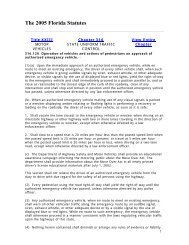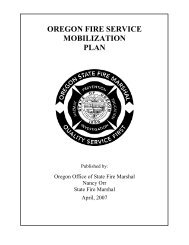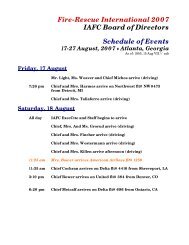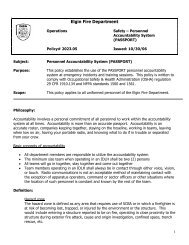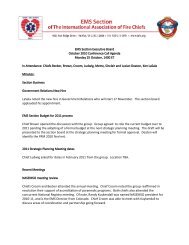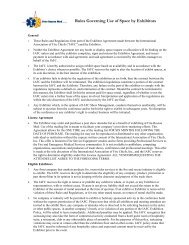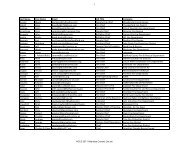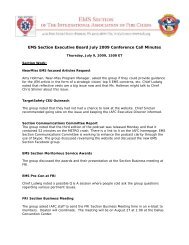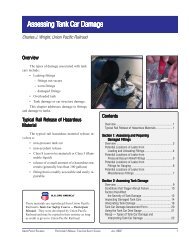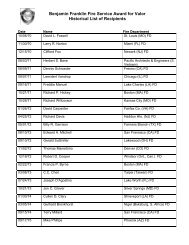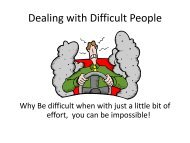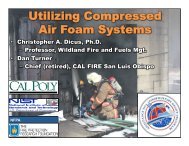Effects of Sleep Deprivation on Fire Fighters and EMS ... - NAEMT
Effects of Sleep Deprivation on Fire Fighters and EMS ... - NAEMT
Effects of Sleep Deprivation on Fire Fighters and EMS ... - NAEMT
Create successful ePaper yourself
Turn your PDF publications into a flip-book with our unique Google optimized e-Paper software.
<str<strong>on</strong>g>Effects</str<strong>on</strong>g> <str<strong>on</strong>g>of</str<strong>on</strong>g> <str<strong>on</strong>g>Sleep</str<strong>on</strong>g> <str<strong>on</strong>g>Deprivati<strong>on</strong></str<strong>on</strong>g> <strong>on</strong> <strong>Fire</strong> <strong>Fighters</strong> <strong>and</strong> <strong>EMS</strong> Resp<strong>on</strong>ders<br />
2.11 Documentati<strong>on</strong> <str<strong>on</strong>g>of</str<strong>on</strong>g> CMV Operator Hours<br />
Each trucker who drives in interstate commerce is<br />
required to keep accurate records <str<strong>on</strong>g>of</str<strong>on</strong>g> his/her duty<br />
status. Current rules allow truckers to use a log <strong>on</strong><br />
an approved grid (Figure 2.2) or an automatic <strong>on</strong>board<br />
recording device. As with other essentially voluntary<br />
enforcement schemes (such as the tax code), cheating<br />
is believed to occur. In the case <str<strong>on</strong>g>of</str<strong>on</strong>g> an accident,<br />
records can be checked against the expense receipts<br />
<strong>and</strong> other paperwork.<br />
Figure 2.1. <str<strong>on</strong>g>Sleep</str<strong>on</strong>g> Laboratory Assessment<br />
2.12 Countermeasures <strong>and</strong> Driving<br />
The obvious countermeasure to drowsy driving is<br />
getting more restorative sleep. Countermeasures like<br />
cold air or a loud radio are not routinely effective (Reyner & Horne, 1998), <strong>and</strong> as described,<br />
drivers are poor judges <str<strong>on</strong>g>of</str<strong>on</strong>g> their fatigue levels. If they feel fatigued, they are, but those not feeling<br />
tired also may be significantly impaired. Caffeine <strong>and</strong> naps are discussed in Secti<strong>on</strong> 5.<br />
Efforts are underway to develop devices for m<strong>on</strong>itoring sleepiness in real-life c<strong>on</strong>diti<strong>on</strong>s, but so<br />
far n<strong>on</strong>e have been proven effective (see text box next page). Driver m<strong>on</strong>itoring systems that<br />
reliably wake up drowsy drivers, without providing too many false alarms, are not available,<br />
<strong>and</strong> even if they worked as expected from a technical point <str<strong>on</strong>g>of</str<strong>on</strong>g> view, there is c<strong>on</strong>cern that such<br />
systems may result in reliance <strong>on</strong> those devices at the expense <str<strong>on</strong>g>of</str<strong>on</strong>g> appropriate rest (Dinges &<br />
Mallis, 1998).<br />
The American Transportati<strong>on</strong> Research Institute (ATRI) encourages commercial drivers to adopt<br />
a pers<strong>on</strong>al lifestyle <str<strong>on</strong>g>of</str<strong>on</strong>g> wellness, health <strong>and</strong> fitness as a precursor to driver alertness <strong>and</strong> managing<br />
fatigue. ATRI’s approach advocates that carriers encourage drivers to pers<strong>on</strong>alize their own<br />
wellness, health <strong>and</strong> fitness program <strong>and</strong> to obtain sufficient sleep. The ATRI endorses educating<br />
drivers <strong>on</strong> the effects <str<strong>on</strong>g>of</str<strong>on</strong>g> fatigue, the need for eight hours <str<strong>on</strong>g>of</str<strong>on</strong>g> uninterrupted sleep to decrease<br />
fatigue, using short planned naps to restore a fatigued<br />
individual’s alertness <strong>and</strong> minimizing repeated sleep loss<br />
to prevent a chr<strong>on</strong>ic sleep debt which can negatively affect<br />
performance.<br />
More recently, safety practices have focused <strong>on</strong> the higherrisk<br />
driver, based <strong>on</strong> findings that a relatively small<br />
percentage <str<strong>on</strong>g>of</str<strong>on</strong>g> individuals are resp<strong>on</strong>sible for an inordinate<br />
crash risk (Knipling et al., 2004). Surveys <str<strong>on</strong>g>of</str<strong>on</strong>g> fleet safety<br />
managers were used to identify those higher-risk<br />
individuals, <strong>and</strong> methods to avoid their hiring <strong>and</strong> means<br />
to m<strong>on</strong>itor <strong>and</strong> modify their behavior have been published<br />
(http://www.fmcsa.dot.gov/facts-research/researchtechnology/tech/high-risk-commercial-driver.pdf).<br />
The<br />
Transportati<strong>on</strong> Research Board <str<strong>on</strong>g>of</str<strong>on</strong>g> the Nati<strong>on</strong>al Academies<br />
prepared the report, Commercial Truck <strong>and</strong> Bus Safety<br />
Synthesis Program (CTBSSP) Synthesis 4: Individual<br />
34



